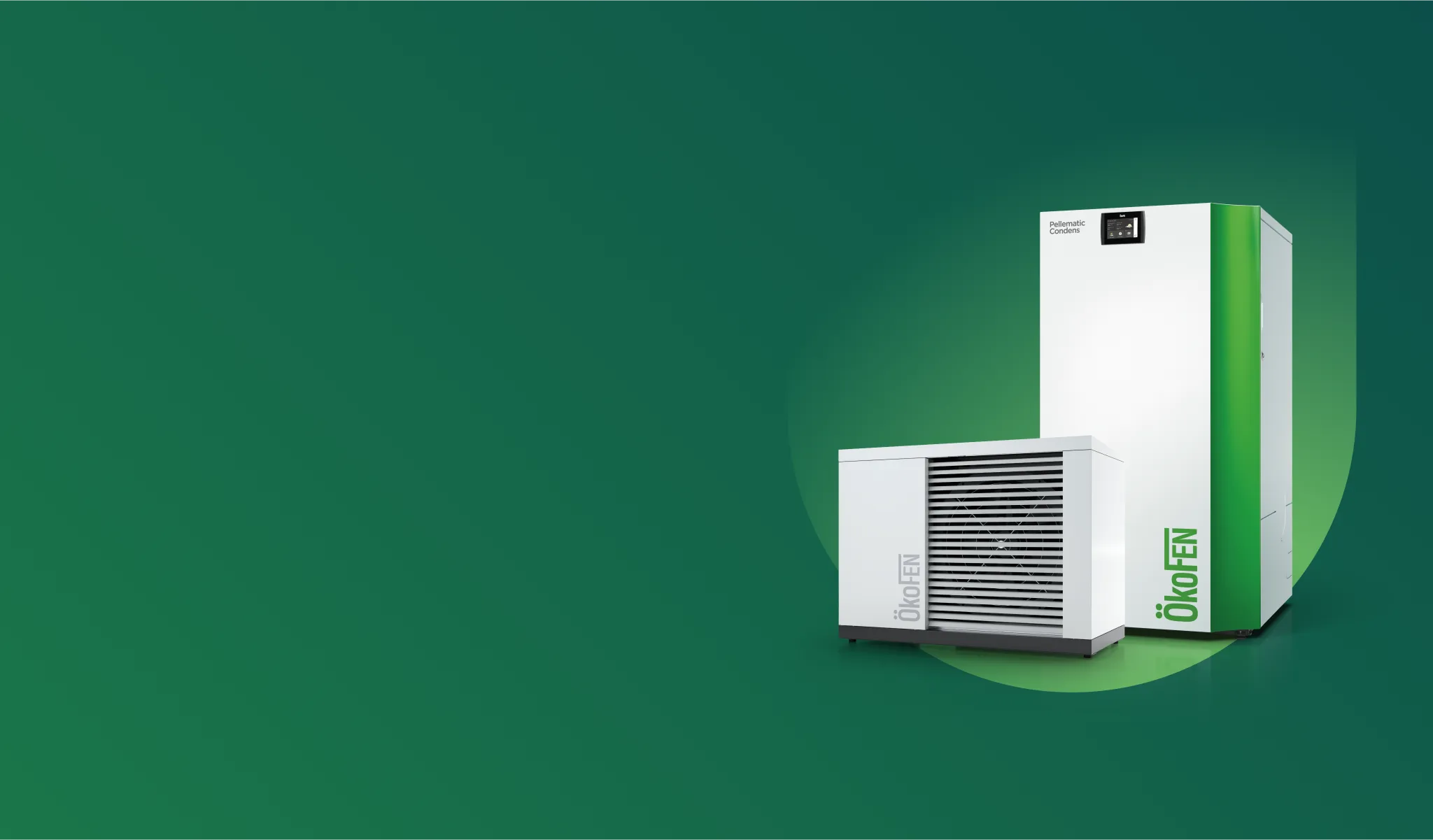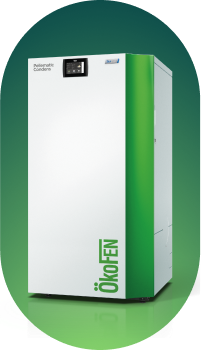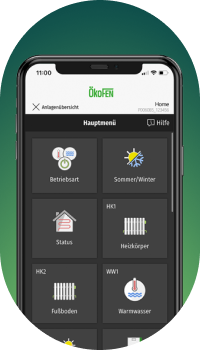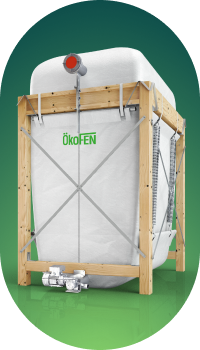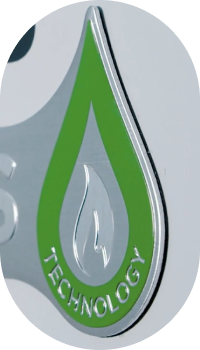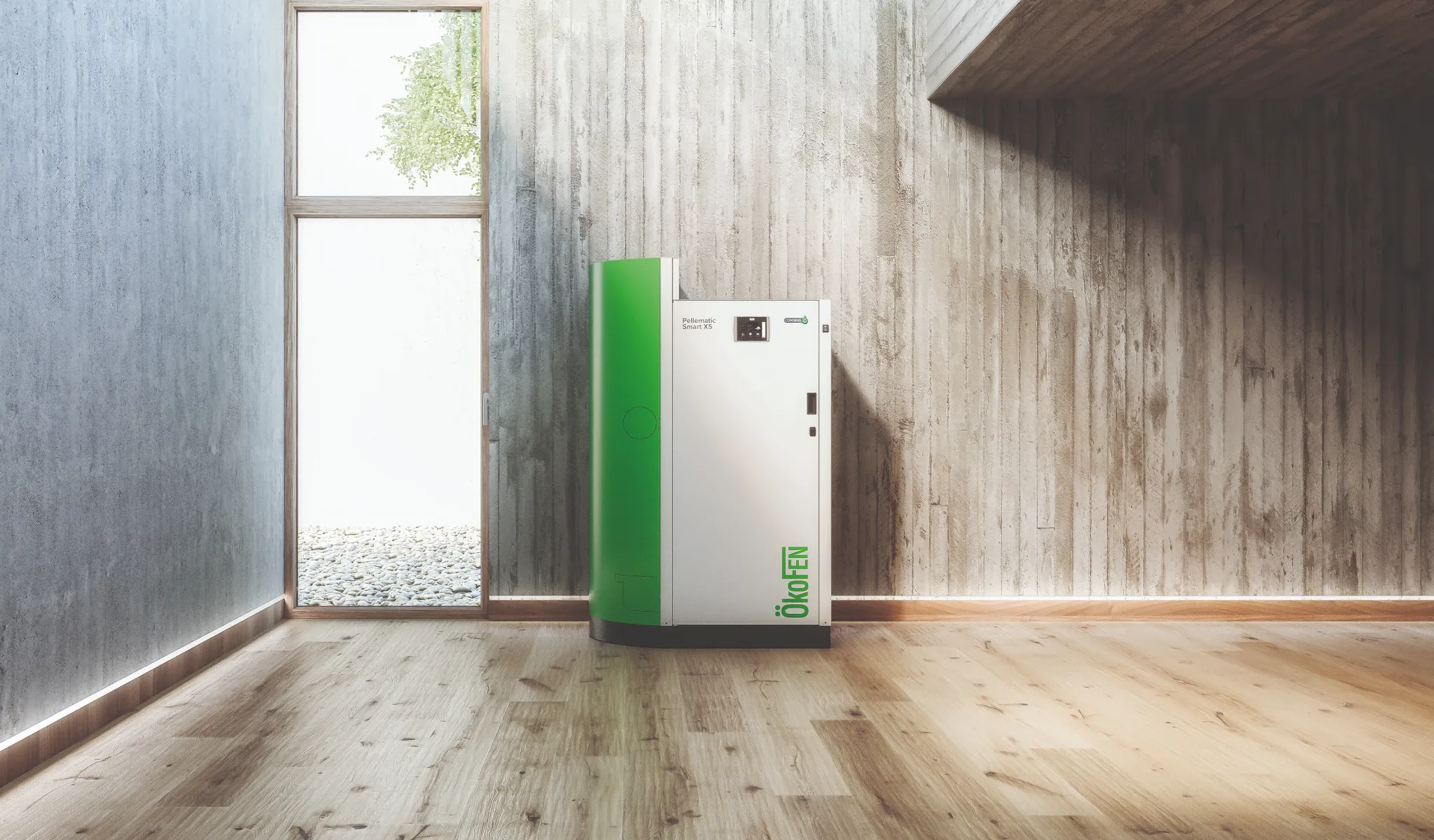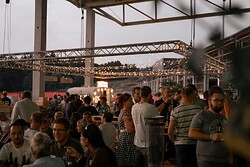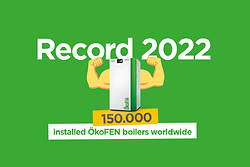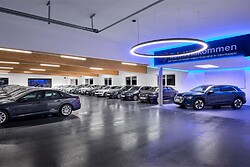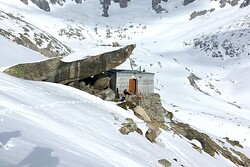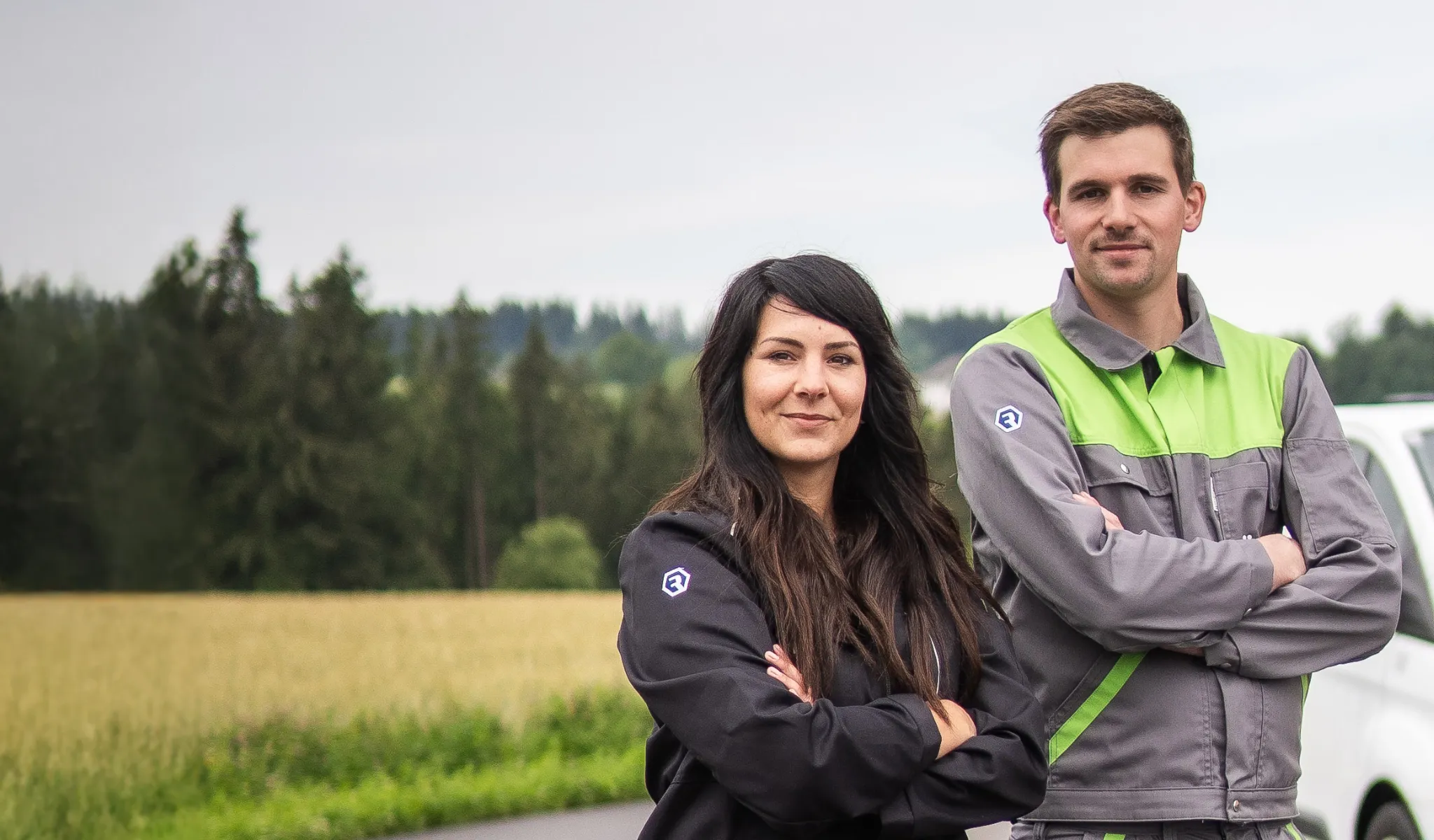The ÖkoFEN product world
ÖkoFEN pellet heating: Our pellet heating systems at a glance
ÖkoFEN specializes in pellet heating systems and has been one of the world's leading providers of innovative solutions in the renewable energy sector since 1997. From economical and convenient pellet heating systems to space-saving pellet tanks. Whether for single-family homes, communities or businesses, you've come to the right place when it comes to heating with wood pellets!
Why choose an ÖkoFEN pellet boiler?
In addition to the convenient and sustainable heating of your home, an ÖkoFEN pellet boiler offers you even more benefits.
News from ÖkoFEN
How climate-friendly is heating with pellets?
With an ÖkoFEN pellet heating system, you can rely on an environmentally friendly and future-proof heating solution. Thanks to the latest combustion technology, such as the innovative ZeroFlame technology, pellets burn extremely cleanly and with little fine dust. Compared to fossil fuels such as oil or gas, the combustion of wood pellets only releases as much CO2 as the tree has previously absorbed during its growth - a closed cycle that protects our environment.
With the ÖkoFEN CO2 calculator, you can easily find out for yourself how much CO2 you can save by switching from oil or gas to a pellet heating system.
Questions and answers on the subject of pellets
Here you'll find the most frequently asked questions (& answers) about heating with pellets or heat pump.
Would you like a quick overview of heating sustainably? Or do you need well-founded answers for your sales pitch? You’ll always find what you’re looking for in our FAQs.
In short, for ecological, economic and ideological reasons. The combustion of wood pellets is CO2-neutral. In other words, they release the same amount of CO2 during their combustion as the tree had previously absorbed from the air and converted to oxygen.
Heating with wood pellets is sustainably cost-effective. Since the price of pellets is not coupled with the oil price, but determined by the market forces of supply and demand, it is predictable and has constantly been cheaper than heating oil for many years.
Wood is a regional raw material and the wood pellet industry is well-developed. This results in several benefits for consumers: They are supporting the regional economy and creating jobs. In contrast to oil, which is predominantly supplied from crisis regions such as the Middle East, or compared to gas, the supply of which likewise depends on political decisions in foreign countries, owners of pellet boiler systems heat with a reliable fuel.
The best thing about a pellet boiler: For all these benefits, it provides practically the same level of convenience as an oil or gas heating system, and it can also be implemented flexibly: both in family homes and in the commercial and industrial sector. A pellet heating system is always the suitable solution.
Wood pellets are cylindrical pressings made from dry, natural wood waste (wood shavings and sawdust) from the sawmill industry.
They have a diameter of 6 mm and a length of 10 to 25 mm. They are pressed at high pressure – without chemical binding agents – and have an extremely low water content as well as a high energy content and calorific value. Wood pellets are supplied in kilograms. 1 m³ of pellets weighs 650 kg.
In comparison:
2 kg pellets >> approx. 1 litre oil
1 m³ Pellets >> approx. 320 litres oil
The name
No.
Exclusive use is made of waste from wood processing in the production of wood pellets. In the sawmill industry, for example, up to 35 percent of each processed tree remains unused in the form of wood chippings and sawdust. This proportion can be used for pellet production. Furthermore, wood is a renewable resource, and Germany has the largest timber resources in Europe with around 3.6 billion m³. New growth adds another 120 million m³ to this each year. Only around 70 percent of the wood that regrows every year is used at all economically and not even 5 percent in the form of pellets. In addition, legally prescribed, sustainable forest management ensures that over-exploitation of the forests is prevented.
Widely dispersed production and trading structures ensure the availability of pellets throughout Germany.
With annual production of 2.1 million tonnes in 2014, Germany is the country with the highest production volume after the USA. Furthermore, domestic pellet manufacturers produce more pellets than are actually consumed nationally. The remaining amounts are currently exported. In keeping with the number of production facilities, a network of over 300 pellet dealers has developed in the meantime.
In contrast, the provision of oil and gas is anything but sustainable, because fossil fuel supplies are dwindling quicker than expected.
Pellet producers are investing for the future.
The production capacity of German pellet manufacturers is constantly increasing. With new investments, they are bracing themselves for the growing demand. At present some 30 percent of the production volume is exported abroad.
As in all other energy markets, the pellet price is subject to certain fluctuations. However, the diverse supply structure makes the pellet market transparent and consequently very consumer-friendly. The pellet price has remained at a stable level for the last ten years or so, in contrast to fossil energy sources like oil and gas. The oil price doubled in the last eight years, while the pellet price rose by less than 20 percent over the same period.
In general, it is advisable to fill pellet stores in summer, because the price in winter is mostly higher than in warmer months.
The price of pellets is not coupled with the oil price; it is governed by supply and demand.
The pellet price has remained stable in recent years. Independence from stock-market speculation and international crises – which are a matter of course in the trading of fossil fuels – represents another guarantee for the price stability of wood pellets.
Climate-neutral heating is rewarded by the state and state subsidies are available to everyone who converts to a pellet heating system. Pellets are an affordable fuel that amortises the acquisition costs of a new, modern pellet boiler within a few years.
The energy input for pellet production only amounts to approx. 2.7 percent of the calorific value of pellets.
In comparison, the energy input is approximately 12 percent for heating oil and approximately 14.5 percent for liquefied gas.
Since January 2010, the ENplus seal of approval for pellets has guaranteed the efficient, environmentally friendly operation of pellet heating systems.
Dry pellets release significantly more energy than those with a high moisture content. In addition, standardised pellets allow the combustion technology to be set very precisely, so up to 95 percent of the pellet energy content can be utilised. Users who heat with high-grade pellets also benefit from lower cleaning expenditure. With its strict limits, the new standard ensures impeccable pellet quality throughout Europe. For the first time, the entire supply chain from production through to delivery at the end user’s site is monitored, thereby guaranteeing greater consumer protection. Apart from the calorific value, the standard also defines the water content, ash content, length, diameter and other criteria. So, when purchasing pellets, make sure that they bear the ENplus and DINplus seals of approval – the corresponding quality criteria are binding for the certified manufacturers. Further information can be found at www.enplus-pellets.de
The calorific value of pellets is standardised at 4.9 kWh/kg.
The calorific value of one litre of extra-light heating oil is 10 kWh/l and that of 1 m³ natural gas is also 10 kWh.
Therefore: 2 kg pellets ~ 1 litre extra-light heating oil ~ 1 m³ natural gas.
Fundamentally, there are two options: A storage tank made of high-quality polyester fabric or a pellet storage room.
The storage tank is quick and easy to install, cost-effective and dust-tight. Furthermore, the fabric is permeable to air, which makes the tank the perfect storage option for pellets. If it is protected from sun and rain, it can even be sited outside the building. Moreover, innovative storage tanks have 60 percent more storage capacity for the same space requirement. Pellets are delivered by tanker, from which the pellets are blown into the storage room or tank by compressed air. In contrast to oil, pellets cause no unpleasant smells and are stored cleanly with accustomed convenience.
Pellets can be stored indefinitely when stored in dry conditions.
Not only the pellets themselves need to be high quality, but also the equipment and design of the storage room.
The walls, floor and ceiling of the store must therefore be absolutely dry, as otherwise the wood pellets could swell up and fall apart. Damp pellets can lead to malfunctions during transport from the store to the pellet boiler, as well as during combustion.
In the case of a separate pellet storage room, a smooth sloping floor with a minimum inclination of 45 degrees must always be installed. If no sloping floor is provided, the inclination is too shallow or the surface too rough, then pellets can become stuck.
The pellets above this layer slide over the static pellets, with the remaining wood pellets acting as a sieve.
No combustion takes place without any emissions.
However, the combustion in pellet boilers is CO2-neutral, because only as much carbon dioxide is released as the tree absorbed previously during its growth and would release in the natural rotting process. CO2 emissions are therefore very low. In addition, pellet boilers already comply with the limits for fine dust stipulated in the stricter Federal Emission Control Act (BImSchV) which apply from 2020. Combustion monitoring, automatic fuel feed and air regulation – in conjunction with the standardised dry fuel made of natural wood without additives – mean that pellet heating systems can already meet these strict criteria today, without any filters.
Consumers benefit from the investment in a new heating system over 15 to 20 years – they want a future-proof heating system with predictable fuel costs.
With an additional product range, you can offer your customers a wider selection, which, in turn, makes you more attractive. If you take an extra step and specialise in pellet heating systems, you can even create a unique selling point for yourself compared to your local competitors. As a specialist in regenerative fuels, you can broaden your customer base.
Pellet boilers are flexible in their application and suitable for every heating system. Be it for radiators, wall or underfloor heating, for family homes or commercial buildings. For buildings without cellars or if the available space is intended for use as valuable living or storage areas, ÖkoFEN can supply heating centres for outdoor installation.
The systems solutions from ÖkoFEN, comprising pellet boiler, solar collector and suitable buffer cylinder, simplify the planning process for every specialist heating company, require less installation time thanks to pre-installed components and ensure their customers a functional, homogeneous system. ÖkoFEN’s nationwide customer service network guarantees short journeys and rapid response.
Questions and answers on the subject of heat pumps
An air source heat pump generates noise during operation. The sound power level can vary depending on the model, manufacturer, size and environment. In general, modern air source heat pumps are relatively quiet, especially compared to older models. The sound power level or sound pressure level is given in decibels dB (A) and is what we generally understand by "volume".
During operation, air source heat pumps typically generate a sound power level of between 50 and 70 dB (A). Some heat pumps, such as the GreenFOX heat pump, are even lower.
To get an idea of how loud this is, here are some comparative noises:
50 dB(A): Comparable to a quiet conversation or a refrigerator.
60 dB(A): Similar to the volume in an average office.
70 dB(A): Comparable to a normal conversation in a restaurant.
It is important to note that the actual noise level of an air source heat pump also depends on factors such as the distance to the pump, the environment in which it is installed and the power setting of the pump. Some manufacturers also use sound insulation to reduce noise pollution.
An air source heat pump is a heating and cooling appliance that utilises thermal energy from the ambient air and uses it to heat or cool rooms.
Here is a basic explanation of how an air source heat pump works:
1. Absorption of ambient heat: The air source heat pump extracts heat energy from the ambient air, even at low temperatures. Even in cold weather, the air still contains enough heat energy that can be utilised.
2. Vaporisation of the refrigerant: The heat pump contains a closed circuit containing a refrigerant. This refrigerant has a low boiling point and evaporates at low temperatures when exposed to the heat of the ambient air.
3. Compression of the refrigerant: The vaporised refrigerant vapour is compressed by a compressor, which increases the pressure and temperature.
4. Release of heat: The compressed and heated refrigerant vapour releases the stored heat energy to the heating system or hot water tank to heat the room or provide hot water.
5. Condensation of the refrigerant: After the heat has been released, the refrigerant condenses back to a liquid state, releasing the heat energy.
6. Refrigerant expansion: The liquid refrigerant passes through an expansion valve, which reduces the pressure and temperature to close the circuit and return the refrigerant to the evaporator.
This cycle is repeated continuously as long as the heating or cooling system is active. A heat pump can utilise the energy obtained from the ambient air to heat the house. In summer, the principle can be reversed to cool the house.
It is important to note that an air source heat pump reduces its efficiency as outside temperatures fall, as the thermal energy in the cold air is limited. In such cases, supplementary heating systems may be required to cover the heating requirements.
The cost of an air source heat pump depends on various factors, including performance, energy efficiency, brand and installation effort. In general, prices for air source heat pumps tend to range from a few thousand euros to tens of thousands of euros.
It is also important to consider additional costs for installation, maintenance and, if necessary, replacement of parts over time. There may also be regional and national subsidy programmes that provide financial support for the purchase and installation of heat pumps. It is advisable to find out about these options in order to realise potential savings.
The cost of a heat pump for an old building can vary greatly depending on various factors. There are different types of heat pumps and the total cost depends on several factors, including
1. Heat pump size and capacity: the size of the heat pump is calculated based on the heating requirements and the size of the building.
2. Type of heat source system: The choice of heat source (e.g. air, ground, groundwater) influences the cost.
3. Existing infrastructure: If underfloor heating or suitable radiators are already present, the costs may be lower.
4. Installation costs: The installation costs depend on the complexity of the installation and the accessibility of the property.
5. Subsidies: In some regions, there are state subsidy programmes that can reduce the cost of installing a heat pump.
As a rough guide, the cost of a heat pump in an old building could be between €20,000 and €35,000 (without taking into account possible subsidies!). However, the actual costs should always be determined by individual quotations from specialist companies who carry out a precise analysis of the conditions on site.
In principle, a heat pump can also be worthwhile in an old building if certain conditions are met:
1. Insulation of the building: The energy quality of the old building plays a decisive role. The better the building is insulated, the more efficiently the heat pump can work. However, if the building has poor insulation, the heat pump may not be able to generate enough heat to cover the heating requirements in winter.
2. Heating load: The size of the heat pump must be matched to the heating load of the building. An accurate calculation of the required heat output is important to ensure that the heat pump is adequately sized.
3. Heat distribution: The heat distribution in the old building should also be checked. Ideally, there should be radiators or underfloor heating that can be operated with low flow temperatures for the heat pump. If not, changes may need to be made to the heating system.
4. Availability of geothermal heat or ambient air: The heat pump can either draw heat from the ambient air (air-to-water heat pump) or from the ground (geothermal heat pump or brine-to-water heat pump). The local conditions and available resources play a role here.
5. Cost-benefit analysis: It is important to compare the investment costs for the heat pump and its installation with the potential energy savings over the lifetime of the system. Subsidy programmes and financial incentives can increase the economic attractiveness.
In summary, it can be said that a heat pump in an old building is particularly worthwhile if the building is well insulated, the heat distribution can be optimised and a sufficient heat source (ambient air or geothermal energy) is available. Individual consideration and advice from specialists, such as energy consultants or installers, is advisable in order to find the best solution for the old building in question.
Anyone renovating or building a new home often asks themselves what the key differences are when heating with pellets vs. a heat pump.
Here we have summarised the most important points for comparing modern pellet heating with a heat pump:
Features/differences
In contrast to pellet heating, the geological conditions must be right for heating with geothermal heat pumps. In addition, the boreholes require authorisation and the collectors take up a lot of space in the garden. The pellet boiler with hot water tank and pellet store, on the other hand, fits into the smallest boiler room. If required, an outdoor tank for the pellets can also be installed next to the house. This takes up hardly any space thanks to its compact design. The air heat pump, which is installed in a very space-saving manner like a modern pellet heating system, can generate a lot of noise during the heating period. Pellet heating systems, on the other hand, work with highly efficient combustion methods and produce so little noise that they can even be installed on your ground floor. The air heat pump also finds it more difficult than the pellet heating system to compensate for a very high heat requirement - at extremely sub-zero temperatures.
Environmental friendliness
Heating with pellets is and remains the most environmentally friendly form of comfort heating. When burning wood pellets, only as much CO2 is released as the tree has extracted from the atmosphere while growing. It is therefore climate-neutral. The emissions generated during the production and transport of the pellets only create a very small CO2 footprint. Although no material is burnt when heating with heat pumps, the high electricity consumption actually causes twice as many CO2 emissions as heating with pellets, as the electricity mix for the heat pump is sourced from various power stations in Germany and abroad. With both heating systems, however, you can connect a photovoltaic system and thus produce and use your own electricity.
Operating costs
The heating costs for pellet boilers and heat pumps are roughly the same.
If you want an ecological heating system, you should be aware that a heat pump only works sustainably with green electricity. The heat pump often means being dependent on electricity providers and their electricity prices. With a pellet boiler, it is much easier to know that sustainable heating is guaranteed. If you look for regional, certified fuels when buying pellets, you are on the safe side.
Hybrid heating is a heating system that combines two or more different heating technologies in order to heat more efficiently and flexibly. The idea behind hybrid heating is to utilise the advantages of different energy sources and compensate for possible disadvantages in order to ensure efficient and cost-effective operation and to be more independent.
Typically, a hybrid heating system combines a renewable energy source with a conventional heating source. In the best case, two or even three renewable energy sources are installed together with all their efficiency advantages.
Here are some common combinations:
1. Heat pump heating with a gas or oil condensing boiler: The heat pump utilises environmental heat (e.g. from the air, ground or groundwater) and converts it into heat. At low temperatures or high heat demand, the gas or oil condensing boiler can step in and support the heating system.
2. Solar thermal energy with a gas or oil condensing boiler: Solar thermal energy uses solar energy to produce hot water. If the solar radiation is not sufficient, the gas or oil condensing boiler takes over the hot water preparation.
3. Wood pellet or biomass boiler with an oil or gas heating system: Wood pellets or biomass are burnt and converted into heat. When the nominal output of the system is reached, the oil or gas heating system kicks in.
4. Wood pellet heating with a heat pump heating system: The heat pump runs for 9 to 10 months of the year to heat water or for heating in autumn/spring and for cooling in summer. The pellet heating system is switched on for the main heating months in winter. This minimises heating costs during operation, maximises comfort and ensures maximum energy independence.
5. Wood pellet + photovoltaic + heat pump heating: For even more energy independence, the heat pump can use the electricity from your own photovoltaic system (PV system). In December/January/February, a pellet heating system is also useful here for efficient peak load coverage.
6. Pellet heating + solar thermal energy: Solar thermal energy uses solar energy to generate hot water. If the system cannot cover the heat demand - i.e. if the solar radiation is not sufficient - the pellet heating system takes over the hot water preparation.
The advantage of hybrid heating is that it can significantly increase energy efficiency and reduce dependence on a single energy source. This enables flexible adaptation to the current energy supply situation and can lead to cost savings in the long term.
The price of a hybrid heating system can vary greatly depending on various factors, including the size of the building to be heated, the heating technologies chosen, installation costs and regional conditions. A hybrid heating system usually combines two different types of heating, e.g. a heat pump with a pellet heating system.
A hybrid heating system may require a higher initial investment than a conventional single heating system, but in the long term the operating costs can be lower due to the efficient use of renewable energies. Government subsidies or local incentives could also influence the overall price.

